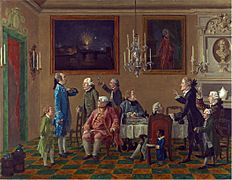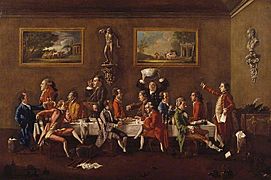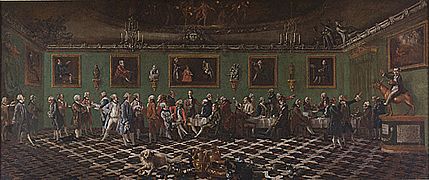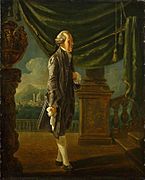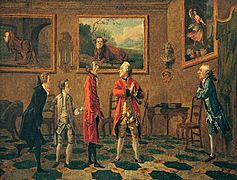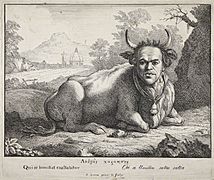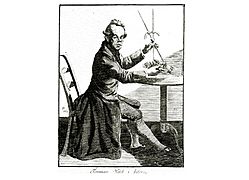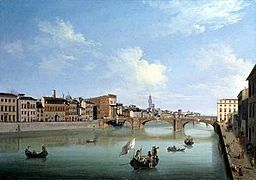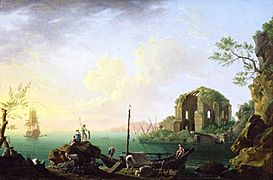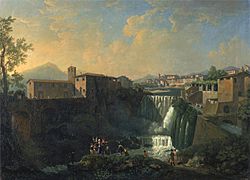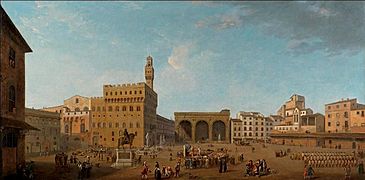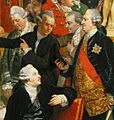Thomas Patch facts for kids
Quick facts for kids
Thomas Patch
|
|
|---|---|
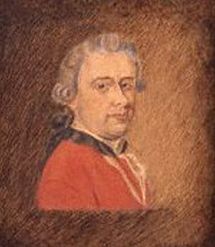
Self-portrait, 1761
|
|
| Born | 13 March 1725 |
| Died | 30 April 1782 (aged 57) |
| Nationality | English |
| Education | Medicine |
| Known for | Painter, Caricaturist |
Thomas Patch (born March 13, 1725 – died April 30, 1782) was an English artist. He was a painter and also made prints using a technique called etching. He was known for painting beautiful views of cities like Florence and Tivoli. He also created many funny group pictures called caricatures, especially for young British travelers on the Grand Tour. The largest collection of his paintings and prints is kept at the Lewis Walpole Library in Farmington, Connecticut.
Thomas Patch's Life Story
Patch was born in Exeter, England, in 1725. His father was a well-known doctor, and Thomas was expected to become a pharmacist. However, he did not finish his medical studies. Instead, he traveled to Rome in 1747 with Richard Dalton, who later became the librarian for King George III.
In Rome, Patch met another famous painter, Joshua Reynolds. At first, Patch worked for an artist named Joseph Vernet. He painted landscapes of Tivoli and made copies of Vernet's work.
In 1755, Patch had to leave Rome. He moved to Florence, Italy, where he lived for the rest of his life. He was helped by his friend Sir Horace Mann. Mann was the British representative in Florence and helped Patch connect with British tourists.
In Florence, Patch studied how human faces show personality. Sadly, his detailed notes on this topic were stolen and burned. However, some of his work in this area still exists. In the late 1760s and early 1770s, he quickly made many prints. These prints helped people identify the figures in the funny group pictures he painted. These caricature paintings are his most famous works.
Patch was also one of the first artists to seriously study early Italian art. He published several series of prints that showed works by famous artists like Giotto, Masaccio, Ghiberti, and Fra Bartolommeo. He probably planned to create even more. In 1772, he published a book about Fra Bartolommeo. He dedicated it to Horace Walpole, who was a major art collector. Walpole was a relative of Horace Mann, which was a helpful connection for Patch.
Like many other artists living abroad, Patch also earned money by selling artworks to Grand Tourists. These were wealthy young people who traveled around Europe to learn about art and culture.
Towards the end of his life, Patch painted less. He became sad because he could not finish all his projects. He became very ill at Mann's house on April 29, 1782, and died the next day at his own home.
How Thomas Patch Appears in Art
Thomas Patch appears in a famous painting by Johann Zoffany called "The Tribuna of the Uffizi". In this painting, Patch is shown with Sir Horace Mann and others. They are looking at a famous statue. Zoffany shows Patch with one hand on the painting and the other pointing towards a sculpture of wrestlers.
Patch also made two etchings of himself. In one, his head is on the body of a bull. He also included himself in several of his caricature paintings. In paintings at the Royal Albert Memorial Museum in Exeter and the Yale Center for British Art, he is shown as a sculpted bust on a wall. In a very long painting at the Lewis Walpole Library called "The Golden Asses", Patch is shown riding a donkey. This painting shows a party of Englishmen at Sir Horace Mann's house in Florence.
Art Gallery
-
British Gentlemen at Sir Horace Mann's Home in Florence (circa 1765), including John Tylney, 2nd Earl Tylney; currently at the Yale Center for British Art, Paul Mellon Collection
-
John Ker, 3rd Duke of Roxburghe (circa 1761)
Images for kids
-
Detail from Tribuna of the Uffizi. From left to right (standing): Mr Gordon, Patch, Sir John Taylor Bt, Sir Horace Mann and in front Felton Hervey


